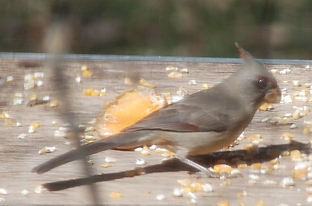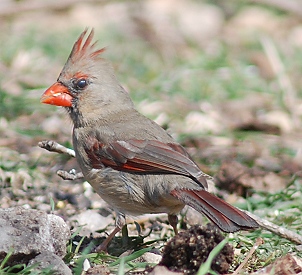In December 2002, I was birdwatching at the site of what would be Fox Pavilion (hadn’t been built yet.) We had a flock of cardinals that showed up every day…but that day, there was a female bird with them that wasn’t a cardinal. It was a Pyrrhuloxia, a close relative whose normal range is well west of here.
I had only a little point and shoot camera then, and it was a heavily cloudy day, late in the afternoon, so my pictures of the female Pyrrhuloxia weren’t very good–just good enough to show that’s what it had to be. That female was somewhat melanistic, very dark indeed, noticeably darker than the female cardinals perched in the same scrubby trees.
I watched every winter, but did not see another one until today: on the feeder in the back yard. I wasn’t able to get a picture of it except through the study window–old glass, and can’t be opened so it can’t be cleaned–so it’s blurry–and handheld with my less-great lens, but here it is:

Pyrrhuloxia, female
Note that the bill is yellow, with the upper part (culmen) sharply curved, and the bird is a cool gray, with minimal red in the crest, around the eye, and in the folded wing.
Here’s a female cardinal (but this taken outside, so there’s no blurring by the old dirty glass in the window and with my best lens) as gray as they look in our yard–usually they show warmer colors–and always the red bill and more red in crest, eyes, wings, and tail.

Even though the Pyrrholoxia picture isn’t as good as I’d wish, it’s still nifty to see one back again, this time in sunlight and close enough to see details with the binoculars. I expect these “desert cardinals” (as we called them when I was a kid) to appear in our area more often as climate change makes it hotter and dryer.
Comment by hannah — February 5, 2009 @ 6:14 pm
They are fantastically beautiful! They look like they stopped by so the the human can take a picture of them. The gray Pyrrhuloxia and the female cardinal are quite clear, as far as my computer screen can show. Maybe as a hard copy photo, one wants a 100% sharp image. But for the female cardinal, the blur on the window actually serves art. I could have thought you did it in purpose, e.g. blur the background to put in focus the subject in the foreground.
Comment by hannah — February 5, 2009 @ 6:17 pm
Web image of 80acreonline — the trees and the huge sky — is fantastic.
Comment by cdozo — February 5, 2009 @ 8:12 pm
I love both pictures. I’ve only seen a Pyrrholoxia once (that I know of). It was a male. I saw when I lived by Bull Creek. At first I thought it was a mutant cardinal, but somehow I found out what it really was. I remembered the name as containing the letters pyrxa.
Now I know its real name. Thanks.
Comment by elizabeth — February 5, 2009 @ 10:33 pm
Glad you all enjoyed the pictures. I thought it was interesting that the pyrrhuloxia was never on the feeder when a cardinal was, but as soon as a cardinal left, there it was again. It seemed to want cardinals nearby–if they flew away, it flew with them–but it “knew” it wasn’t really the same.
Tomorrow is supposed to be cloudy, but if the bird comes back I will try again to go out and take pictures of it without the window in the way. It’s shy, though, and slow to come back when something’s spooked it.
Now if I can just figure out how to keep bees from thinking that my hair, my hands, and the camera are potential nectar sources…the one today that got right in my face, my hair, and on the camera was a definite distraction.
Comment by Marilyn Holt — February 6, 2009 @ 6:49 pm
What a great thing. I worry so when we don’t see bird species, as I suspect you do, too, so then they return it is a relief.
Comment by elizabeth — February 6, 2009 @ 7:44 pm
They’re unusual enough here (their main range is west and south of here) that it’s a joy to see one but not something to worry about if they’re not around for a year or so. We’re having a severe drought and their home range is dryer than this in normal years, so I was watching to see if one would move east and north in search of water. This one did. There may be others; I’ve alerted the bird listserv I’m on.
I worry more about the bobwhite quail, which were abundant here 30 years ago, but now are almost never seen.
Comment by OtterB — February 11, 2009 @ 9:25 am
Thought this might be of interest.
“An Audubon Society study to be released Tuesday found that more than half of 305 birds species in North America, a hodgepodge that includes robins, gulls, chickadees and owls, are spending the winter about 35 miles farther north than they did 40 years ago.”
I’m not sure if I’m allowed URLs here. Link is to a news piece by an AP writer, not the full report.
http://www.wtopnews.com/?sid=1597415&nid=220
Comment by elizabeth — February 11, 2009 @ 9:39 am
At least 35 miles north. Overwintering of short-range migrants that normally winter in South Texas (~350 miles) began some years past…we moved here 30 years ago, and there were no white-wings overwintering. That began maybe 15 years ago.
Thanks for the info. I’m only out of bed briefly (pneumonia) so will look at the site later.
Comment by OtterB — February 12, 2009 @ 3:28 pm
I knew from your newsgroup & LJ that you were under the weather and wouldn’t be looking at it right away, but if I didn’t drop a comment in here while I was thinking about it, I wouldn’t have remembered. Glad you’re back at the computer off and on.